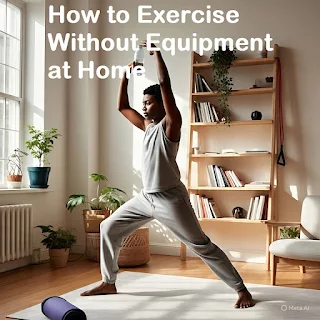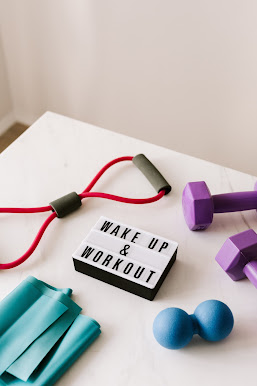How to Exercise Without Equipment at Home: A Simple Guide for Everyone
Let’s be honest: sometimes going to the gym just isn't an option. Maybe you're working from home, trying to save money, short on time, or simply not a fan of crowded fitness centers. The good news? You can still get in great shape without ever stepping foot outside your front door—or buying any fancy equipment. Yup, you heard that right. All you need is a bit of space, your body, and the willingness to move.
In this article, we’ll explore some easy and effective ways to exercise at home, no dumbbells or resistance bands required. Whether you’re a total beginner or someone getting back into fitness, there’s something here for you.
1. Why Bodyweight Workouts Work
Before we jump into the how-to, let’s talk about why working out without equipment is so effective.
Bodyweight workouts are exactly what they sound like—exercises that use your own weight for resistance. Think push-ups, squats, planks, etc. These exercises target multiple muscle groups at once, help you build strength and endurance, and can be adjusted to suit any fitness level.
Plus, they’re:
-
Free
-
Flexible (you can do them anytime, anywhere)
-
Low maintenance (no setup or cleanup)
Now that we’ve covered that, let’s get moving.
2. Start With a Warm-Up
Even if you’re working out at home in your pajamas, warming up is a must. It helps prevent injuries and gets your blood flowing.
Here’s a quick 5-minute warm-up you can do:
-
March or jog in place – 1 minute
-
Arm circles – 30 seconds forward, 30 seconds backward
-
Leg swings – 30 seconds each leg
-
Torso twists – 1 minute
-
Jumping jacks or high knees – 1 minute
That’s it! You’re ready to sweat.
3. The No-Equipment Home Workout Plan
You don’t need a complex routine to start seeing results. Here’s a simple full-body workout you can do using just your body. Aim to do each exercise for 30–45 seconds, followed by 15–30 seconds of rest. Do 2–3 rounds depending on your fitness level.
A. Lower Body
1. Squats
The king of bodyweight exercises. Stand with feet shoulder-width apart, bend your knees and lower your hips like you're sitting in a chair, then stand back up.
Muscles worked: thighs, glutes, core.
2. Lunges
Step forward with one foot and lower your body until both knees form 90-degree angles. Push back to start and switch sides.
Muscles worked: legs, glutes, balance.
3. Glute Bridges
Lie on your back, knees bent, feet flat. Lift your hips toward the ceiling and squeeze your glutes, then lower back down.
Great for: butt and lower back support.
B. Upper Body
4. Push-Ups
A classic. Start in a plank position, lower your chest to the floor, and push back up. Modify by dropping to your knees if needed.
Muscles worked: chest, arms, shoulders, core.
5. Tricep Dips (on a chair or couch)
Sit on the edge of a sturdy surface, place your hands next to your hips, slide forward, and lower your body down, then push up.
Targets: the back of your arms (triceps).
C. Core
6. Plank
Forearms on the floor, body in a straight line, hold it. Focus on engaging your abs and glutes.
Builds: core strength and endurance.
7. Bicycle Crunches
Lie on your back, hands behind your head, and alternate elbow to opposite knee in a pedaling motion.
Works: abs and obliques.
8. Leg Raises
Lie flat and lift your legs slowly to a 90-degree angle, then lower without touching the floor.
Focuses on: lower abs.
4. Cardio Boost Without Equipment
Want to get your heart rate up and burn some extra calories? Mix in some of these no-equipment cardio moves:
-
Jumping Jacks
-
High Knees
-
Burpees (love 'em or hate 'em, they work)
-
Mountain Climbers
-
Skater jumps
You can do a cardio-only session by picking 4–5 of these and doing them in a circuit (30 seconds each, 3 rounds), or just mix them into your strength workout.
5. Cool Down and Stretch
Once you're done, don’t forget to cool down. This part helps reduce muscle soreness and brings your heart rate back to normal.
Try this short stretch routine:
-
Forward fold (hamstring stretch) – 1 minute
-
Quad stretch – 30 seconds each leg
-
Shoulder stretch – 30 seconds each arm
-
Child’s pose – 1 minute
-
Cat-cow stretch – 1 minute
Take deep breaths, hydrate, and give yourself a high five. You did it!
6. Make It a Habit
Starting is great, but consistency is what brings results. The best part about working out at home is you don’t need to carve out a huge chunk of time. Even 20–30 minutes a few times a week can make a big difference.
Here are some tips to stick with it:
-
Schedule it: Pick a time that works for you and stick to it.
-
Start small: Even 10 minutes is better than nothing.
-
Use a timer or app: Keeps you accountable.
-
Follow along with videos: There are tons of free YouTube workouts for all levels.
-
Track your progress: Write down what you did and how you felt. You’ll be surprised how far you go.
7. Listen to Your Body
One of the biggest perks of working out at home is that you get to go at your own pace. If something doesn’t feel right, modify it. If you’re tired, take a break. No shame in resting—your body needs time to recover and get stronger.
Also, don’t stress about doing it “perfectly.” What matters most is that you’re moving and taking care of yourself. Progress, not perfection.
Final Thoughts
You don’t need expensive gear, a gym membership, or hours of free time to get fit. With just your body and a little motivation, you can build strength, improve your mood, and boost your health right at home.
So roll out a yoga mat (or don’t), throw on your comfiest clothes, put on some music, and start moving. Your future self will thank you
Don't Forget to write us about your suggestions and feedback and opinion






0 Comments